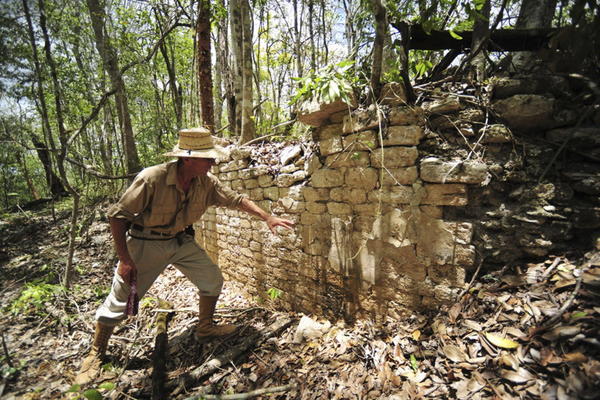Image: A National Institute of Anthropology and History worker shows the remains of a building at the newly discovered ancient Maya city Chactun in Yucatan peninsula. ( INAH/Reuters )
Scientists have discovered what was once likely a prominent city in the booming Mayan empire.
Just weeks after a similar find was made in Cambodia, archaeologists have uncovered an ancient Maya city that been hidden for hundreds of years in the Yucatan’s jungle-covered Campeche province, a find that researchers said could tell us more about how the advanced, still mysterious empire presided over its vast lands at its height.
Just weeks after a similar find was made in Cambodia, archaeologists have uncovered an ancient Maya city that been hidden for hundreds of years in the Yucatan’s jungle-covered Campeche province, a find that researchers said could tell us more about how the advanced, still mysterious empire presided over its vast lands at its height.
The abandoned city, called Chactun, is one of the largest ever found in Mexico’s Yucatan peninsula, teeming with some 30,000 or 40,000 people during the late Classic period of Maya civilization between 600 and 900 AD, after which year the civilization spun into decline. That would have made it somewhat smaller than Tikal, the fabled Mayan city once home to some 90,000 in what is now Guatemala, Reuters reported.
"It is one of the largest sites in the Central Lowlands, comparable in its extent and the magnitude of its buildings with Becan, Nadzcaan and El Palmar in Campeche," said archaeologist Ivan Sprajc in a statement from Mexico's National Institute of Anthropology and History, translated from Spanish by LiveScience.
The city was recently spotted in aerial photographs that had been snapped some 15 years ago by the National Commission for the Knowledge and Use of Biodiversity. A team of archeologists then spent about three weeks cutting a 10-mile path into the opaque jungle to reach the site marked on their aerial map.
So far, the archeologists have found in the 54-acre stretch some 15 pyramids, one of which is about 75 feet tall, as well as ball courts that indicate the city was likely a prominent one in the empire. Researchers hope that in studying the features of Chactun they will better understand the relationship between the Mayan empire’s various cities, as well as learn more about the civilization’s stunning decline after centuries of cultural ingenuity and territorial expansion, Reuters said.
The Maya civilization was one of the great civilizations that controlled then pre-Columbian rolling jungles of Central America and whose collapse has become an almost mythologized piece of modern lore. At its peak, the Mayans presided over the entire Yucatan, as well as over Belize, Guatemala, and Honduras. Scientists believe that a combination of population growth and climate change might have pushed the civilization under.
The discovery of the Mayan city comes just days after an announcement from half-a-world-over that Cambodia's Khmer Empire may have been laid out in a carefully coordinated urban plan, rather than as a loosely organized collection of population centers. That ancient civilization - which left behind the tales of Cambodia's mythical origins recorded on its sky-grazing stone temples - is also thought to have been brought to its knees from a combination of environmental degradation and population growth.
Source: http://www.csmonitor.com









No comments:
Post a Comment